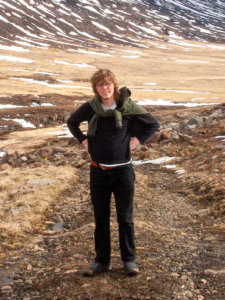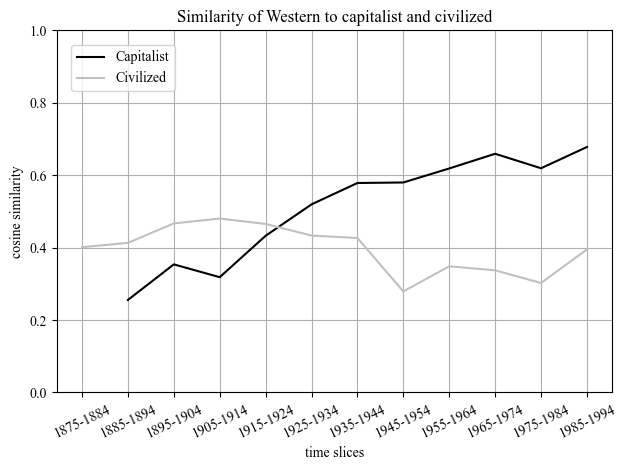Interviews
Interview with Edo Storm, winner of the Digital History Thesis Award 2023
Edo Storm used a combination of computational methods and close reading to conduct research into the history of the term ‘the West’. It earned him this year’s Digital History Thesis Award. Storm: ‘I wouldn’t have seen the big overarching narrative without this computational method.’

Fellow students sometimes joked about him and his ‘digital stuff’ when Edo Storm once again started to enthusiastically say that working with code really wasn’t as difficult as they all thought. ‘Most historians are a bit technophobic’, Storm laughs, ‘but that is starting to change with the younger classes below me, where it is becoming a bit more popular.’
During his research master History, Storm worked as a student assistant for Pim Huijnen and did an internship for Joris van Eijnatten at the e-Science Center. Storm: ‘I had decided to, once a day, ask a colleague something. And that was always super useful, because there is so much knowledge at the e-Science Center. I felt privileged to be able to brainstorm with the people there. There I learned the digital skills I needed for my thesis.’ The Centre for Digital Humanities spoke to him about his research.
What exactly did you research for your thesis?
‘I have looked at how the term ‘the West’ has evolved in the Dutch discourse in the late nineteenth and twentieth century. What ideological or cultural meaning was there in this concept and how has that changed? And to what extent are quantitative methods useful to answer these questions?’
So you also asked the question what quantitative methods add to your research at all?
‘Yes, I have the feeling that the digital humanities is still in such a self-reflective phase that I have to explain why I wanted to apply this in a history thesis.’
How did you get the idea to look at the concept of ‘the West’?
‘I think the term ‘Western society’ is a very interesting concept. There is a lot of hidden meaning in it. I wrote this thesis when the war against Ukraine broke out, so I was very alert to the term. The newspapers were full of sentences like ‘what is the West going to do?’ As if it makes perfect sense that we – the West – should do something.’
What were the main outcomes?
‘What I have seen from my results is that the West, or the idea of the West, emerged in a somewhat more orientalist sense in the late 19th century. This orientalist approach was based on the cultural difference of the ‘civilized’ West on the one hand and the ‘uncivilized’ East on the other. From the Second World War on, a change took place and the term ‘the West’ became more about ideology. This makes sense of course; from the Cold War onwards, it was more about a capitalist and democratic West versus a communist and authoritarian East. What is striking, for example, is that since the 1990s, Japan has been described as Western, because the country then started to resemble Western countries in terms of ideology and economy.’
You have applied both close reading and computational methods. What did you use for what?
‘I used the close reading method to visualize the moment of the discursive shift that took place around the time of the Second World War. For this I used Johan Huizinga’s book Geschonden Wereld. Huizinga talks very explicitly about the history of East and West, and also about the moment when that shift happened. I used the quantitative method for the larger narrative and timeline. By using word embedding – word frequencies – I could see what that evolution looked like over the entire period.’

How do you use word embedding?
‘This is now a trendy technique, especially in digital history. With this technique you train a model based on your dataset. In my case, I trained twelve models for the twelve different decades. Using word embeddings, I then looked at which other words most closely resembled the word ‘Western’. Because the word ‘Western’ also has a more neutral geographic meaning, I have worked with the Dutch adjective ‘Westers’. That worked well because the adjective in Dutch always has that cultural or ideological meaning. The algorithm then looks at the relationships between words and gives a certain score based on how much a certain word resembles another word. I was then able to generate a list of the words that are closest to ‘Western’ according to that algorithm. It’s very interesting what you see in it. In the graph ‘Similarity of Western to capitalist and civilized’ (see image above), you can see that the similarity first corresponds more to ‘civilized’ and then you see a transition to ‘capitalist’.’
And did that match your predictions?
‘I started with an open mind, but when I saw the results, it all fell into place. Things that are hinted at in literature, I can now substantiate. In retrospect, it is perhaps a bit obvious that the meaning has become more ideological after the Cold War, but to see that transition in the data was very special. In that sense, this thesis is my addition to the historiography. I’m really happy with that.’
What was a challenge you encountered?
Through the National Library I was able to use Delpher, that contains all digitized Dutch-language newspapers of the past centuries. At first I wanted to work with fifteen newspapers, but that was way too much for my personal laptop. Then it would have taken a month to train those models. In the end I used seven newspapers, and my laptop still had to run for a week.’
Wasn’t there a computer with a larger memory that you could use?
‘I inquired about them, but they are only available to physics and mathematics students. In my epilogue I make an appeal that it would be nice if that infrastructure were available to all students.’
The Digital history thesis award is awarded annually since 2022 by the Department of History and Art History for the best undergraduate, graduate and research master’s thesis in digital history. Find the news article here.
You can read Edo Storm’s thesis here.

